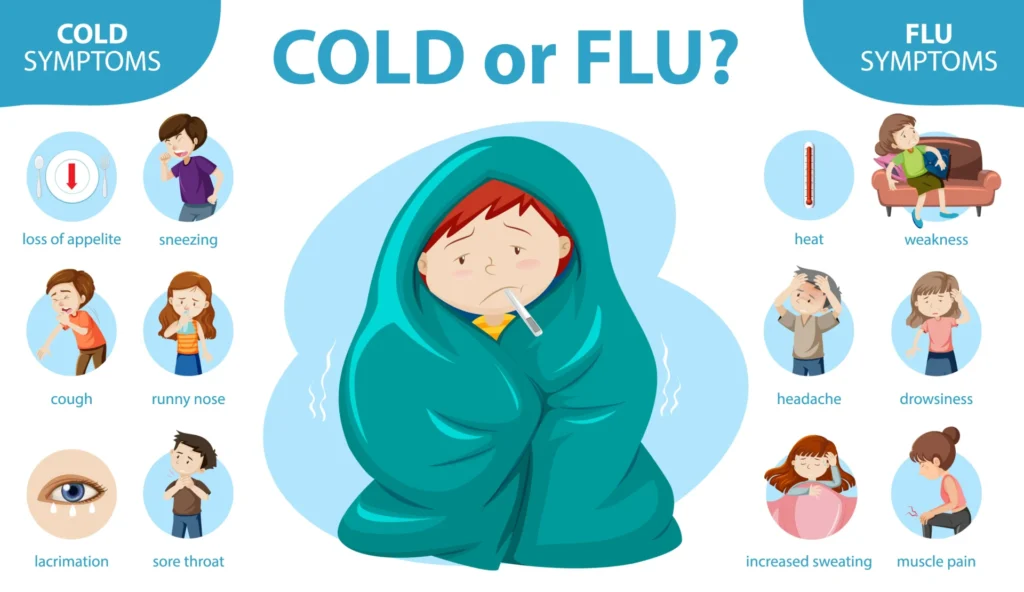As the 2025 flu season approaches, many are asking, will flu symptoms 2025 differ from past years? While the flu typically presents with a set of well-known symptoms, variations in flu strains can lead to slight differences year by year. Understanding these changes is key to staying prepared and protecting your health.
This article focuses on recognizing flu symptoms in 2025, helping you differentiate between the flu, the common cold, and other illnesses with overlapping symptoms. We’ll also highlight warning signs that signal the need for immediate medical attention. With this knowledge, you’ll be equipped to navigate the flu season with confidence and clarity.
Let’s explore what you need to know about this year’s flu symptoms, how to spot them early, and when to seek professional care.
Key Flu Symptoms to Watch For in 2025
While the core flu symptoms tend to stay consistent, being aware of what to expect during the 2025 flu symptoms season is crucial. Recognizing these signs early can help you seek treatment promptly and avoid complications. Here are the key flu symptoms 2025 might bring:
- Fever: A sudden high fever, often exceeding 100°F (38°C), is one of the most noticeable signs of the flu.
- Cough: A persistent cough, either dry or producing mucus, is a hallmark of influenza.
- Sore Throat: Many flu sufferers report a painful, scratchy throat.
- Muscle Aches: Generalized muscle aches, often described as deep and throbbing, typically affect the back, arms, and legs.
- Headache: Flu-related headaches can range from mild discomfort to severe pain.
- Fatigue: Extreme tiredness, making even simple tasks challenging, is a common flu symptom.
- Chills and Sweats: Alternating episodes of chills and sweating as your body battles the virus.
- Runny or Stuffy Nose: While more typical of a cold, nasal congestion or a runny nose can occasionally occur with the flu.
What Is Usually the First Symptom of Flu?
The flu often strikes suddenly. The first symptom of flu is commonly a rapid onset of high fever, body aches or extreme fatigue. You may feel completely fine one moment and severely unwell the next. Chills or an overall feeling of malaise can also precede other symptoms.
Important Note:
The specific combination and severity of symptoms can vary from person to person. While these are common flu symptoms 2025, only a healthcare professional can confirm a proper diagnosis and recommend appropriate treatment. If you’re unsure or your symptoms worsen, it’s vital to seek medical advice promptly.
Flu vs. Cold vs. COVID-19: Key Differences in Symptoms

Distinguishing between the flu, a common cold, and COVID-19 can be tricky since they share overlapping symptoms. However, understanding the key differences can help you identify what you might be experiencing and take appropriate action.
What Are the Differences Between Flu Symptoms and COVID Symptoms in 2025?
Although both the flu and COVID-19 are contagious respiratory illnesses, they are caused by different viruses. For the most current and reliable information, consult resources like the CDC. Below is a general comparison to highlight the distinctions in their symptoms during the flu symptoms 2025 season:
| Symptom | Flu (Influenza) | Common Cold | COVID-19 |
| Fever | Common, often high (100°F+) | Rare | Common, can be high |
| Cough | Common, can be severe | Mild to moderate | Common, often dry |
| Muscle Aches | Common, often severe | Mild | Common, can be severe |
| Fatigue | Common, often severe | Mild | Common, can be severe |
| Headache | Common | Sometimes | Common |
| Sore Throat | Common | Common | Sometimes |
| Runny/Stuffy Nose | Sometimes | Common | Sometimes |
| Chills | Common | Uncommon | Common |
| Shortness of Breath | Sometimes, usually with underlying conditions | Rare | Common, can be severe |
| Loss of Taste/Smell | Rare | Rare | Common, often a distinguishing feature |
Key Differences to Keep in Mind:
- Sudden Onset: Flu symptoms tend to appear suddenly and are intense from the start, whereas cold symptoms develop more gradually.
- Fever: A high fever is common with the flu and COVID-19 but less frequent with colds.
- Muscle Aches: Severe muscle aches are a hallmark of the flu, less common with colds, and can vary with COVID-19.
- Loss of Taste/Smell: Strongly associated with COVID-19, this symptom is rare in both the flu and colds.
Important Note:
This comparison provides general guidance and is not a substitute for medical advice. If you’re experiencing any of these symptoms, especially those resembling flu symptoms 2025 or COVID-19, consult with a healthcare professional for proper diagnosis and treatment. Testing may be recommended to confirm or rule out COVID-19, ensuring you receive the right care.

What Are the Five Stages of Flu?
The flu or influenza, typically progresses through five distinct stages. Knowing these stages can help you better understand the illness, manage symptoms effectively, and plan for recovery.
1. Incubation Period
- What Happens: The time between exposure to the virus and the appearance of symptoms.
- Duration: Typically lasts 1–4 days.
- Key Insight: Although you may feel fine, you can still be contagious during this phase.
2. Prodromal Stage
- What Happens: Early, mild symptoms start to appear, such as slight fatigue, general malaise, or a sore throat.
- Duration: This stage usually lasts 1–2 days.
- Key Insight: These early warning signs can signal the onset of more severe symptoms.
3. Acute Stage
- What Happens: The flu hits its peak, with severe symptoms like high fever, chills, muscle aches, headache, cough, and extreme fatigue.
- Duration: Lasts 3–5 days, though certain symptoms like fatigue or cough may persist longer.
- Key Insight: This is the most intense phase and often requires rest, hydration, and symptom management.
4. Recovery Stage
- What Happens: Symptoms begin to subside, with fever typically resolving. However, you may still feel weak or tired.
- Duration: Usually lasts a few days to a week.
- Key Insight: While you’re on the mend, it’s important to avoid overexertion to prevent setbacks.
5. Convalescence Stage
- What Happens: Energy levels gradually return to normal. Mild fatigue or a lingering cough may persist.
- Duration: Recovery during this stage can take up to two weeks or longer, depending on the individual.
- Key Insight: Complete recovery may take time, so patience is essential.
Important Note:
The severity and duration of each stage vary from person to person. While some may experience mild symptoms, others might face a more severe illness. If symptoms worsen or persist beyond typical timelines, consult a healthcare professional. Taking proactive care at each stage is key to a smoother recovery.
When to Seek Medical Attention
While most cases of the flu can be managed at home with rest and over-the-counter remedies, there are instances when it’s crucial to consult a doctor or seek emergency care. Recognizing flu symptoms 2025 and these warning signs early can make a significant difference in preventing severe complications.
Which Flu Symptoms Require Emergency Care?
If you or someone you know experiences any of the following symptoms, seek immediate medical attention:
- Confusion or difficulty staying awake
- Difficulty breathing or shortness of breath
- Persistent chest pain or pressure
- Seizures
- Severe or persistent vomiting
- Bluish lips or face
- Symptoms that improve but then return with a high fever and a worsening cough
These signs may indicate serious complications such as pneumonia, dehydration, or other life-threatening conditions that require urgent medical intervention.
High-Risk Groups
Certain groups are at greater risk of developing severe flu-related complications and should be especially vigilant. If you fall into one of these categories, contact your doctor at the first sign of flu symptoms 2025:
- Older Adults: Those aged 65 and older.
- Young Children: Especially children under the age of 5, and even more so those under 2.
- Pregnant Women: Flu can pose risks to both the mother and baby.
- People with Chronic Medical Conditions: Includes individuals with asthma, diabetes, heart disease, or weakened immune systems.
Key Takeaway:
For high-risk individuals, early medical intervention can significantly reduce the risk of serious complications. If you’re uncertain about your symptoms or notice them worsening, don’t hesitate to contact your healthcare provider. Your health and safety should always come first.
Conclusion
This guide has offered a thorough overview of flu symptoms 2025, detailing everything from their initial onset to when it’s critical to seek medical attention. By understanding how to recognize flu symptoms and differentiate them from similar illnesses like the common cold or COVID-19, you can take swift action to manage the flu effectively.
Taking flu symptoms seriously, particularly if you’re in a high-risk group, is vital for preventing complications. If you notice severe symptoms or your condition deteriorates, seeking prompt medical care can make all the difference.
For more insights on influenza, including flu treatment, prevention strategies, and detailed comparisons of flu symptoms vs cold and flu symptoms vs COVID, explore our comprehensive flu guide. Stay informed and prepared to navigate the 2025 flu season with confidence.
Frequently Asked Questions (FAQs)
What are flu symptoms in 2025?
While specific strains can vary slightly, flu symptoms 2025 are expected to be similar to previous years. These include fever, cough, sore throat, muscle aches, headache, fatigue, chills, sweats, and sometimes a runny or stuffy nose. The onset is typically sudden and more intense than a common cold. Keep in mind that only a lab test can determine if you have the flu.
What are the symptoms of the newest flu?
The “newest flu” typically refers to the most recently circulating strains. Symptoms remain consistent with general flu symptoms: fever, cough, sore throat, muscle aches, headache, fatigue, and chills. The severity and combination of symptoms may vary depending on the strain. For the latest information on circulating flu strains, check updates from health organizations like the CDC.
How long does the flu last?
The flu usually resolves within 1–2 weeks. However, certain symptoms, like fatigue and cough, may persist longer, especially in more severe cases.
Can I get the flu even if I got the flu shot?
Yes, it’s possible to get the flu despite being vaccinated. The flu vaccine targets the strains predicted to be most prevalent but is not 100% effective. That said, vaccination often reduces the severity and duration of symptoms if you do contract the flu.
Is there a cure for the flu?
There is no specific “cure” for the flu. However, antiviral medications, if taken within the first 48 hours of symptom onset, can:
- Shorten the duration of the illness.
- Reduce the severity of symptoms.
These medications are available only with a doctor’s prescription.
How can I prevent the flu?
The most effective way to prevent the flu is by getting the annual flu vaccine. Additional preventive measures include:
- Washing hands frequently with soap and water.
- Avoiding close contact with people who are sick.
- Covering your mouth and nose when coughing or sneezing.
- Maintaining a healthy lifestyle to boost your immune system.
By following these practices, you can reduce your risk of encountering flu symptoms 2025 and help prevent the spread of the flu to others.






